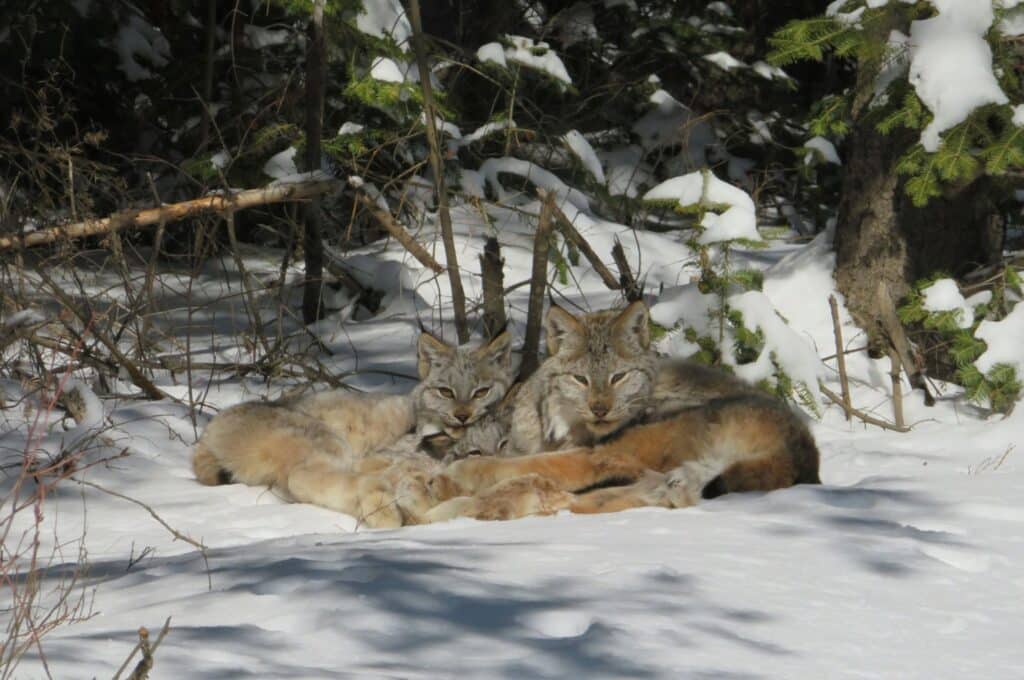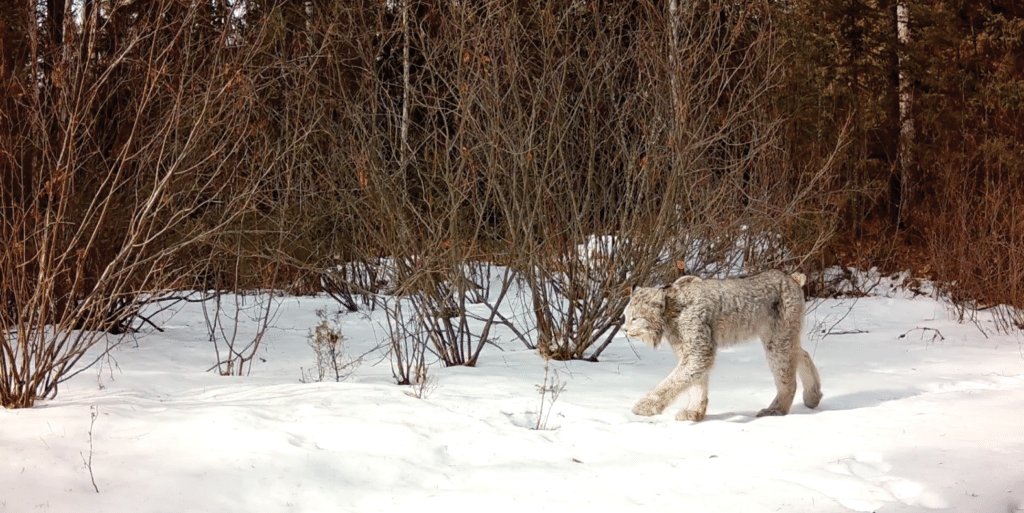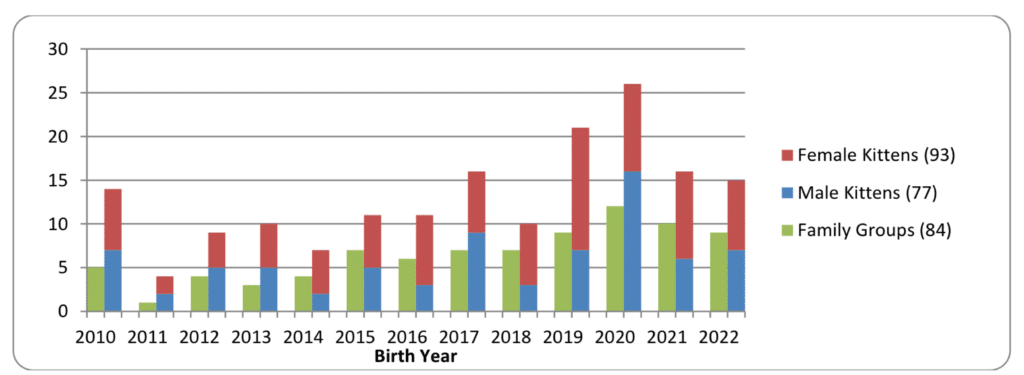
The U.S. Fish and Wildlife Service recently implemented a Draft Recovery Plan to strengthen habitat protection and support breeding populations of the Canada lynx. The population has maintained healthy numbers for the past decade; however, it could change. Dubbed “the gray ghost,” lynx prefer boreal and mixed conifer-hardwood forests. Covering 3,900,000 acres, the Superior National Forest (SNF) provides an ideal habitat for lynx. They play a crucial role in maintaining a delicate balance within the ecosystem. Current estimates indicate a population of 200 animals in northern Minnesota.
The Canada lynx (Lynx canadensis) is a medium-sized wild cat identified by dense mottled fur and triangular ear tufts. Its broad, snowshoe-like paws help it stay aloft during winter as it hunts small game, including snowshoe hares. This creates a prey-predator cycle as the lynx population responds to the cycles of snowshoe hare populations through the seasons. Male Canada lynx typically occupy a home range of 56 to 94 square miles, whereas females usually cover an area of 20 to 47 square miles. Because of this, animals are elusive, hard to track, and well-adapted to living in the dense forest.
Tracking populations
Various methods are used to gather data. During the winter, biologists head into the woods to track lynx movements, and collect samples (usually scat but also hair and tissue). These samples are sent to the USDA Forest Service Rocky Mountain Research Station’s National Genomics Center for Wildlife and Fish Conservation for testing. DNA analysis determines sex and individual characteristics. Meanwhile, ongoing field observations are conducted to monitor reproduction rates and success. Additionally, public sightings are gathered, recorded, and added to a database.
The SNF recently conducted a survey showing that lynx are maintaining their numbers. Thirty-five individuals were identified in 2013 with a significant increase of 118 in 2023. “During the 2022/2023 survey season, 317 samples were collected and submitted for testing. Two hundred and ninety-eight (94.0%) were identified as lynx, 274 of those (86.4%) were able to be genotyped, identifying 118 individuals: 55 female and 63 male.” As a result, trends over the past decade show an increasing or stable population.

Conservation through the lens
During his off hours, Ryan Pennesi, a USFS wildlife technician, uses trail cameras and various camera-trap photography equipment to track lynx. This enables him to monitor animals using the least invasive methods. When an animal walks by the remote camera, it triggers and captures a photo.
In an article from WTIP, he said that the USFS detected the recurrence of one specific lynx. “One thing we learned is we had one lynx that persisted for over ten years,” he said. “So that means from one season to the next, we picked up the scat from the same individual.”
He sees multiple benefits of camera tracking. People are encouraged to use trail cameras on their properties and report their findings to the DNR. Doing so not only fosters a stronger connection to the land but also equips experts with crucial insights into population trends. This leads to better management and conservation practices.

Populations remain stable, for now
Assessments from the U.S. Fish and Wildlife Service’s Draft Recovery Plan (DRP) indicate that various traits of the lynx help determine its vulnerability. Specific attributes, such as geographical distribution, dispersal capability, and ability to respond to prey cycles, suggest versatility to changing conditions. However, other elements such as habitat specialization, genetic diversity, and population size limitations could restrict their adaptive capacity.
Overall there are no immediate threats to the population’s genetic health or adaptability. However, limited geographic regions and habitats may prohibit movement. Their capacity to adjust to anticipated climate shifts is uncertain.
The Draft Recovery Plan includes a multipronged approach to conservation, with some examples being:
- Maintain or improve resiliency in each of the five Distinct Population Segments (DPS) breeding populations. This includes northeastern Minnesota;
- Maintain or improve connectivity between DPS populations and the core of the species’ range in Canada and, to the extent practicable, among DPS populations;
- Maintain or restore habitats within the focal areas of all six species status assessment units and any other areas potentially capable of supporting resident breeding populations;
- Reduce or remove threats to the DPS by maintaining or strengthening habitat protections (i.e., regulatory mechanisms and voluntary conservation efforts); and
- Monitor lynx demography, distribution, connectivity, habitat quality, regulatory mechanisms, and progress in implementing recovery actions and achieving recovery criteria.
Multiple agencies and experts have coordinated efforts toward conservation initiatives. These agencies include Federal, State, and Tribal partners along with forest ecology research communities, and private landowners. The Canada Lynx received a designation as a distinct population segment and was listed as threatened under the Endangered Species Act in 2000.
The public is encouraged to share photos, videos, or sound recordings to be added to the Natural Heritage Information System (NHIS). Lynx sightings can be reported to the MNDNR.
More info:
- Superior National Forest Officials: Canada Lynx are Thriving in the Arrowhead….for now – Boreal Media
- Camera-trap photography aids conservation efforts of Canada Lynx in Superior National Forest – WTIP
- Summary of the Superior National Forest’s Canada Lynx (Lynx canadensis) DNA database and population monitoring 2023 – USFS
- Draft Recovery Plan for the continuous United States distinct population segment of Canada Lynx – U.S. Fish and Wildlife Service

Wilderness guide and outdoorswoman Pam Wright has been exploring wild places since her youth. Remaining curious, she has navigated remote lakes in Canada by canoe, backpacked some of the highest mountains in the Sierra Nevada, and completed a thru-hike of the Superior Hiking Trail. Her professional roles include working as a wilderness guide in northern Minnesota and providing online education for outdoor enthusiasts.

